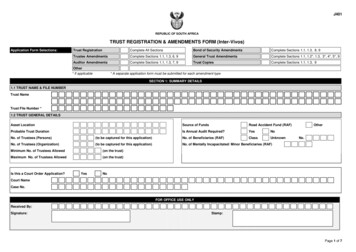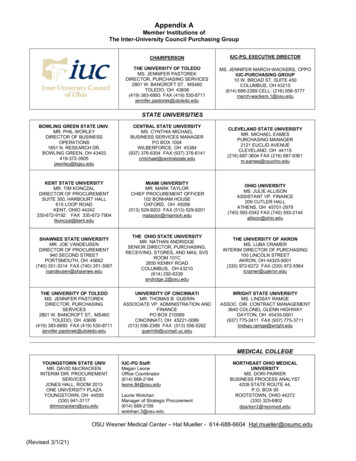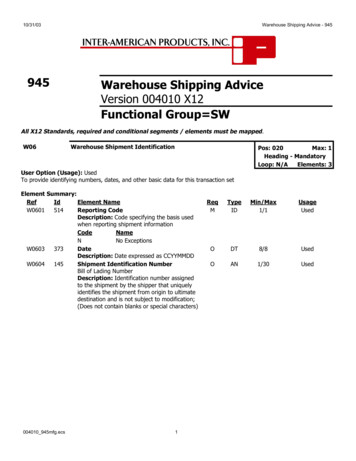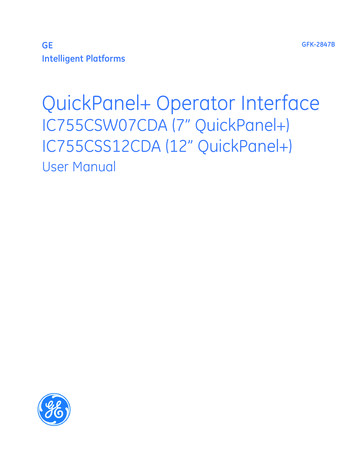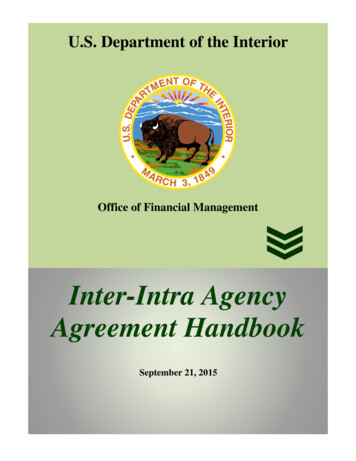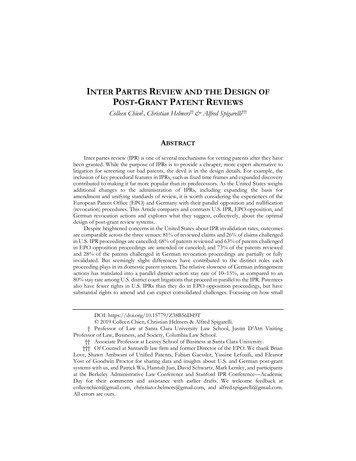
Transcription
INTER PARTES REVIEW AND THE DESIGN OFPOST-GRANT PATENT REVIEWSColleen Chien†, Christian Helmers†† & Alfred Spigarelli†††ABSTRACTInter partes review (IPR) is one of several mechanisms for vetting patents after they havebeen granted. While the purpose of IPRs is to provide a cheaper, more expert alternative tolitigation for screening out bad patents, the devil is in the design details. For example, theinclusion of key procedural features in IPRs, such as fixed time frames and expanded discoverycontributed to making it far more popular than its predecessors. As the United States weighsadditional changes to the administration of IPRs, including expanding the basis foramendment and unifying standards of review, it is worth considering the experiences of theEuropean Patent Office (EPO) and Germany with their parallel opposition and nullification(revocation) procedures. This Article compares and contrasts U.S. IPR, EPO opposition, andGerman revocation actions and explores what they suggest, collectively, about the optimaldesign of post-grant review systems.Despite heightened concerns in the United States about IPR invalidation rates, outcomesare comparable across the three venues: 81% of reviewed claims and 26% of claims challengedin U.S. IPR proceedings are cancelled; 68% of patents reviewed and 63% of patents challengedin EPO opposition proceedings are amended or canceled; and 73% of the patents reviewedand 28% of the patents challenged in German revocation proceedings are partially or fullyinvalidated. But seemingly slight differences have contributed to the distinct roles eachproceeding plays in its domestic patent system. The relative slowness of German infringementactions has translated into a parallel district action stay rate of 10–15%, as compared to an80% stay rate among U.S. district court litigations that proceed in parallel to the IPR. Patenteesalso have fewer rights in U.S. IPRs than they do in EPO opposition proceedings, but havesubstantial rights to amend and can expect consolidated challenges. Focusing on how small DOI: https://doi.org/10.15779/Z38B56D49T 2019 Colleen Chien, Christian Helmers & Alfred Spigarelli.† Professor of Law at Santa Clara University Law School, Justin D’Atri VisitingProfessor of Law, Business, and Society, Columbia Law School.†† Associate Professor at Leavey School of Business at Santa Clara University.††† Of Counsel at Santarelli law firm and former Director of the EPO. We thank BrianLove, Shawn Ambwani of Unified Patents, Fabian Gaessler, Yassine Lefouili, and EleanorYost of Goodwin Proctor for sharing data and insights about U.S. and German post-grantsystems with us, and Patrick Wu, Hannah Jian, David Schwartz, Mark Lemley, and participantsat the Berkeley Administrative Law Conference and Stanford IPR Conference—AcademicDay for their comments and assistance with earlier drafts. We welcome feedback atcolleenchien@gmail.com, christian.r.helmers@gmail.com, and alfred.spigarelli@gmail.com.All errors are ours.
818BERKELEY TECHNOLOGY LAW JOURNAL[Vol. 33:817differences have had big impacts on procedural and substantive outcomes, this Articlediscusses the implications of features such as the ability to amend and pre-institution decisionson the design and efficacy of post-grant patent reviews.
2018]INTER PARTES REVIEW AND POST-GRANT REVIEWS819TABLE OF CONTENTSI.INTRODUCTION . 819II. AN OVERVIEW OF POST-GRANT PATENT REVIEWS INTHE PTO, AT THE EPO, AND AT THE GERMAN DPMA . 825A. POST-GRANT PATENT REVIEW IN THE U.S. .8261. The History of IPR .8262. PGR (First Window Review) .8273. IPR (Second Window Review) .8284. “Life of the Patent” Reviews .829B. IN THE EUROPEAN PATENT OFFICE .8291. Opposition (First Window Review) .8292. Limitation and Revocation (“Life of the Patent”) Reviews .833C. IN GERMANY .8341. German Opposition (“First Window”), Limitation, and Nullity(Revocation) (“Life of the Patent”) Reviews .8342. Nullity (“Second Window”) Reviews .835III. SELECT FEATURES OF POST-GRANT PATENT REVIEW . 838A.B.C.D.AMENDMENT PRACTICE.838SERIAL CHALLENGES .840CLAIM CONSTRUCTION STANDARDS .840COORDINATION BETWEEN INFRINGEMENT AND INVALIDITYDETERMINATIONS .842IV. U.S. (IPR), EUROPEAN (OPPOSITION) AND GERMAN(BPATG) SUBSTANTIVE AND PERFORMANCE-RELATEDOUTCOMES . 843A. INVALIDITY RATES AND RATES OF ADJUDICATION .844B. TIME TO A MERITS-DECISION.847C. BIFURCATION-RELATED OUTCOMES .848V.POLICY IMPLICATIONS . 849A. THE U.S. .850B. GERMANY AND THE EPO .852VI. CONCLUSION . 854I. INTRODUCTIONAlthough only a patent office can grant a patent, patents can be taken awayin multiple venues and multiple ways. In the United States, a patent’s invalidityis typically raised as a defense to a claim of infringement made in a districtcourt or at the International Trade Commission. But increasingly, parties are
820BERKELEY TECHNOLOGY LAW JOURNAL[Vol. 33:817turning back to the agency that issued the patent in the first place—the UnitedStates Patent Office (PTO)—to revisit its validity. The PTO offers severaladvantages over district court for doing so. Post-grant patent reviews (a termwe use to refer to all post-grant review processes including IPR, PGR, CBM,and reexam) support correction of the patent regardless of whether or notthere is a case or controversy,1 they allow generalist juries and judges to avoidthorny technical and legal question, and they support cheaper, more expertadjudication.2 As Congress described when it created several administrativetrial proceedings through the Leahy-Smith America Invents Act (AIA), suchpost-grant proceedings are intended to provide “quick and cost effectivealternatives to litigation.”3But whether or not administrative proceedings are actually faster and lessexpensive than litigation for evaluating the validity of patents depends on howthe proceedings are implemented. At best, inter partes review (IPR) and relatedproceedings substitute for litigation-based validity adjudication by eliminatingthe need for it; for example, when a patent is fully invalidated by an IPR or apatentee’s position is fully or even partially vindicated driving settlement. Butthese proceedings may also complement or supplement, rather than substitutefor parallel proceedings, introducing additional costs, complexities, and delays.This can happen when, for example, the court does not stay co-pendinglitigation, the IPR fails to substantially clarify the status of the patent, or thepatent is subject to multiple serial challenges, each introducing additionaldelays and complications.Whether a particular post-grant patent review operates in practice morelike a substitute or complement to litigation depends on how it is administeredand implemented. While post-grant patent reviews are often discussed ingeneral terms, each form of post-grant review has its own unique purpose andset of procedures. For example, opposition proceedings at the EuropeanPatent Office (EPO) and U.S. post-grant review (PGR) procedures areavailable for the first nine months after the patent is granted (“first window”),4 1. The source of the error may stem from a change in the law (e.g., a new decisionwhich calls into question the validity of a patent that was valid when issued), a change in thefacts (e.g., a new piece of prior art not considered by the patent office), or patent office error.2. See, e.g., Joseph Farrell & Robert P. Merges, Incentives to Challenge and Defend Patents:Why Litigation Won’t Reliably Fix Patent Office Errors and Why Administrative Patent Review MightHelp, 19 BERKELEY TECH. L.J. 943 (2004); Bronwyn H. Hall et al., Prospects for Improving U.S.Patent Quality via Post-Grant Opposition (Nat’l Bureau of Econ. Research, Working Paper No.9731, 2003); Bronwyn H. Hall & Dietmar Harhoff, Post-Grant Reviews in the U.S. Patent System– Design Choices and Expect Impact, 19 BERKELEY TECH. L.J. 989 (2004).3. H.R. Rep. No. 112-98, pt. 1, at 48 (2011), as reprinted in 2011 U.S.C.C.A.N. 67, 78;see also id. at 40 (AIA “is designed to establish a more efficient and streamlined patent systemthat will improve patent quality and limit unnecessary and counterproductive litigation costs”).4. European Patent Convention art. 99(1), Nov. 29, 2001, 1065 U.N.T.S. 284
2018]INTER PARTES REVIEW AND POST-GRANT REVIEWS821other proceedings are only available after this initial period, during the “secondwindow,” and still others are available throughout a patent’s life.5 While someproceedings, such as IPRs, can be initiated by parties other than the patentee,others, such as European limitation and revocation proceedings 6 andAmerican reissue proceedings can only be initiated by the patentee. OnlyAmerican reissue proceedings permit the patentee to enlarge, not diminish, thepatent’s scope, at least in the first two years of the patent’s life.7Table 1: Forms of Post-Grant Patent ReviewsTimingUS8EPOGermany“First” Window9Post-Grant Review nter Partes Review (IPR), NoneCovered Business MethodReview (CBM)Life of the PatentReissue, Ex Parte tions13None [hereinafter EPC].5. See infra tbl.1.6. See, e.g., EUROPEAN PATENT OFFICE, GUIDELINES FOR EXAMINATION,GUIDELINES FOR OPPOSITION AND LIMITATION/REVOCATION texts/html/guidelines/e/d x 1.htm[https://perma.cc/2QDB-LSKZ] [hereinafter EPO EXAMINATION GUIDELINES].7. American reissue proceedings that broaden the patent may only be initiated withinthe first two years of the patent’s life. See 35 U.S.C. § 251(d).8. For a description of various U.S. post grant patent review proceedings, see generally,Joe Matal, A Guide to the Legislative History of the America Invents Act: Part II of II, 21 FED. CIR.B.J. 539 (2012).9. The “first window” represents the time frame within the first nine months after apatent is granted.10. EPC art. 99.11. For an overview of Germany opposition system, see Opposition Systems, WIPO,https://www.wipo.int/scp/en/revocation M37S-64H4] (last visited, Jan. 24, 2019).12. The “second window” represents the time frame any time after the first window.13. Nullity or “revocation” proceedings are heard by a court, not the patent office.However, the scope of review is limited to the patent’s validity. See infra Part II.14. EPC art. 105a.
822BERKELEY TECHNOLOGY LAW JOURNAL[Vol. 33:817When passing the AIA in 2011, Congress focused on the importance ofdesign choices by ushering in three new forms of post-grant patent review:PGR, covered business method (CBM) Review, and IPR.15 The most popularof these, IPR, improved upon its predecessor, inter partes reexamination, byintroducing a strict schedule, conditions that made it favorable for courts tostay their parallel cases, and evidentiary guidelines.16 These small changes havemade a big difference in the uptake of post-grant review: while the PTOreceived fifty-three requests in the first five years of inter partesreexamination,17 the Patent Trial and Appeal Board (PTAB) received 7,930requests in the first five years of IPR (from September 2012 to December2017).18But in addition to being popular, IPR processes have also beencontroversial, principally because they have resulted in the cancellation of alarge share of the claims that the PTO has fully reviewed. By February 2018,65% of final decisions in IPR proceedings concluded that all reviewed claimswere unpatentable, and 16% concluded that some reviewed claims wereunpatentable, resulting in an 81% rate of partial or total invalidity.19The high rate of invalidity and resulting outcry 20 has prompted areconsideration of how IPR is administered. In 2017, the Federal Circuit’sAqua Products decision made it easier for patentees, in certain cases, to amendtheir patents during IPR.21 In 2018, the PTO changed the legal standard for 15. For an overview, see, e.g., Matal, supra note 8, at 623 (2012).16. Id.17. Id. at n. 379 (citing the 2011 Committee Report for the AIA, H.R. Rep. No. 198, at 46,48 (2011)) (reporting that the USPTO received fifty-three requests for inter partes reexam inthe first five years of the proceeding).18. U.S. PATENT & TRADEMARK OFFICE, TRIAL STATISTICS, IPR, PGR, CBM, PATENTTRIAL AND APPEAL BOARD, DECEMBER 2017, s/Trial Statistics 2017-12-31.pdf [https://perma.cc/K6GD-X2RF].19. U.S. PATENT & TRADEMARK OFFICE, TRIAL STATISTICS, IPR, PGR, CBM, PATENTTRIAL AND APPEAL BOARD, FEBRUARY 2018 [hereinafter PTAB FEBRUARY es/documents/trial statistics 20180228.pdf[https://perma.cc/HT9A-MAMR]; see Brian J. Love & Shawn Ambwani, Inter Partes Review:An Early Look at the Numbers, 81 U. CHI. L. REV. DIALOGUE 93, 94 (2014) (reporting a 77%cancellation rate based on the first few years of the program).20. See, e.g., Rochelle Cooper Dreyfuss, Giving the Federal Circuit a Run for its Money:Challenging Patents in the PTAB, 91 NOTRE DAME L. REV. 235, 251 (2015) (describing criticswho believe that the IPR outcomes suggest that PTAB is “out of control”).21. Aqua Products, Inc. v. Matal, 872 F.3d 1290, 1296 (Fed. Cir. 2017) (finding thatpetitioners have the “burden of persuasion with respect to the patentability of amendedclaims” in IRP proceedings, rather than the patentee). The court further held that “the Boardmust consider the entirety of the record before it when assessing the patentability of amendedclaims under § 318(a) and must justify any conclusions of unpatentability with respect toamended claims based on that record.” Id.
2018]INTER PARTES REVIEW AND POST-GRANT REVIEWS823claim interpretation during IPRs to make it consistent with the standardapplied in litigation 22 and moved to explore expansion of the ability ofpatentees as well as to amend their claims during the post grant reviewprocess,23 including “the institution decision, and the conduct of hearings.”24These developments make it timely to consider other post-grant systems thathave been around for longer and, in some cases, have years of experienceimplementing features being considered by the PTO.This Article compares and contrasts three forms of post-grant patentreview: U.S. IPR, EPO opposition proceedings, and German nullification,considering their processes, outcomes, and, collectively, what they imply aboutthe optimal design of post-grant patent reviews. The European oppositionsystem has been around for decades, making it a natural point of comparison.25Further, the availability of data about the European opposition systemsupports a nuanced understanding of how it is carried out in practice. Germanrevocation or “nullification” proceedings provide another useful point ofcomparison because, like IPR, nullification is “second window” review thattakes place after the first nine months of the patent’s life, and often proceedsin parallel with, but independently from, a court’s evaluation of infringement.This raises unique issues with respect to the interplay between the courts andthe IPR system.This Article finds that, although attracting a lot of attention, IPR outcomesare not far outside the norms among other post-grant patent review systems.81% of final written decisions in IPR proceedings partially or fully invalidatethe patent, 26 while more than the 68% of patents reviewed in EPOopposition27 and 73% of patents reviewed in German revocation proceedings, 22. See PTAB Issues Claim Construction Final Rule, U.S. PAT. & TRADEMARK -issues-claim-construction [https://perma.cc/AY29-2CF9] (last visited Jan.24, 2019).23. See PTAB Seeks Comments on Proposed Changes to Motion to Amend Practice in AIA Trials,U.S. PAT. & TRADEMARK OFF., c [https://perma.cc/J36M-XBEF] (last visitedJan. 24, 2019) [hereinafter PTAB Changes to Motion to Amend].24. Andrei Iancu, Director, U.S. Patent & Trademark Office, Statement before theHouse Committee on the Judiciary, (May 22, 2018).25. European opposition has been available since the 1970s. See EPC art. 19.26. It should be noted that a single patent can be subject to multiple petitions. Thus,these figures, as reported by the USPTO, are really at the petition, rather than the patent, level.27. These are numbers from 2017. From 2011 to 2014, about 33% were maintained inamended form and 39% were revoked. In 2015 and 2016, 69% of the opposed patents werepartially or totally invalidated with still more revocation than amended patents. A switch tookplace in 2017 with a larger rate of amended patents than revoked patents. Author analysisbased on EPO figures in consultation with EPO officials.
824BERKELEY TECHNOLOGY LAW JOURNAL[Vol. 33:817which are available after the opposition window has closed, are also partiallyor fully invalidated.28 However, only the U.S. IPR system requires challengesto survive a pre-institution filter. This inflates the invalidation rate in the U.S.because many patents that are challenged are never fully reviewed. When allchallenged (rather than reviewed) patents are considered, U.S. IPR invalidationrates shrink relative to other venues: 26% of patents challenged in U.S. IPRs,63% of patents challenged in the EPO, and 28% of the patents challenged inGerman revocation proceedings are partially or fully invalidated.29But differences in procedures have led to differences in outcomes. Therelative speed and predictability of the U.S. IPR system stands in contrast tothe other venues, particularly German nullity actions, which take place in courtbut at a pace that does not match German infringement actions.30 As a result,only about 10–15% of German infringement proceedings are stayed, 31 ascompared to a partial or full stay rate of 82% in U.S. district court proceedingsin which a stay motion was filed and there is a pending, instituted parallel IPR.32Partly as a result of the low stay rate in Germany, 12% of the injunctionsawarded in Germany rely on patents that are later invalidated.33 Patentees alsohave fewer rights in U.S. IPRs than they do in EPO opposition proceedings,where patentees can more liberally amend their claims and expect aconsolidated, sin
at the Berkeley Administrative Law Conference and Stanford IPR Conference—Academic Day for their comments and assistance with earlier drafts. We welcome feedback at colleenchien@gmail.com, christian.r.helmers@gmail.com, and alfred.
